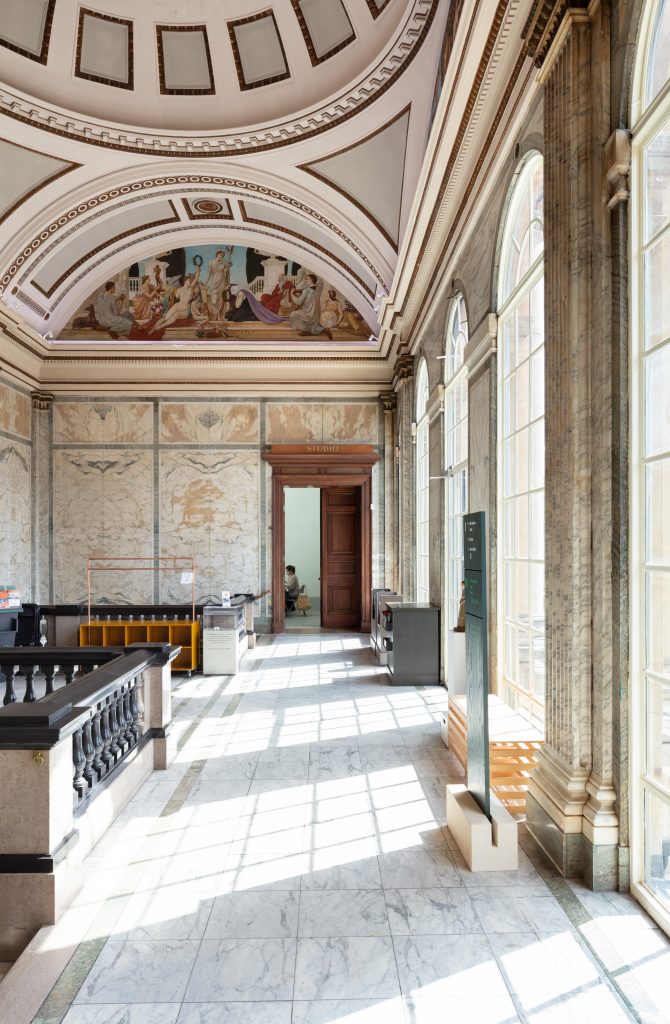Beard completes £3.4m transformation of iconic gallery building

Beard Construction has completed a major £3.4m transformation of the historic and iconic home of one of the South West’s most famous institutions.
The work – known as the Light and Inspiration project – saw a significant revamp of the Grade II*-listed 1858 public gallery of the Royal West of England Academy (RWA) on Queen’s Road in Bristol.

The 11-month project began in May last year with the aim of improving accessibility and enabling natural daylight to cascade through more of the building spaces. While maintaining the building’s main characteristics, the refurbishment included a sympathetic remodelling of the its façade, the re-landscaping of the external forecourt and main foyer, the installation of an external lift, improvements to the retail and reception area, the replacement of two vast gallery roof lanterns, the enlargement of the current café, the installation of new electrics, lighting and underfloor heating, new toilets and changing facilities and a new catering kitchen.
The work represented another significant contract in the heritage sector for family-run Beard Construction, which has an impressive record in the restoration of historic and landmark buildings in the region.
The firm carried out a £5m refurbishment of a Grade II-listed Georgian building for the University of Bristol on Berkley Square, just streets from the RWA, and, in nearby Bath, is currently working on a £6.2m restoration of the historic, Grade II*-listed Cleveland Pools, the oldest outdoor public swimming pool in the UK.
At the RWA, as well as addressing urgent structural repairs to the roof and stonework, Beard’s work has created access to the new lift on all public floors and helped to make the entire space accessible to every visitor. So much so, that the RWA is now dubbed “the most accessible gallery from London to St Ives.” And part of the refurbished space has been made into a quiet room for visitors with sensory issues or autism.
The extra space and access means that the redeveloped building can welcome 40 per cent more visitors a year, making its artwork more accessible to all.
The installation of the external lift was not without its challenges. Rocky ground under the retaining wall meant it had to be propped and held with steels while excavations took place. All materials were brought in by crane and conveyers were used to remove waste material.
The new, ceramic-clad, three-metre-height lift is particularly transformational in terms of access and can carry four wheelchair users and their carers. It also significantly enhances the RWA’s management of art meaning it is ready to facilitate rarer and more interesting pieces. Previously, much of the art, from paintings to sculptures, had to be transported up to the first-floor gallery via the main stone staircase.
The painstaking replacement of the two vast 4x10m, steel-framed roof lanterns, sitting 14m above the main gallery, took about three weeks. The original lanterns were broken out section by section and the new ones lowered in by crane in sections.
The renovation of the external forecourt saw the existing surface removed and replaced with York stone paving as well as the removal of some steps in front of the main door. The façade of the building has been sympathetically reworked and six huge arched windows have had the sills and brickwork under them removed to create impressive, full-length glass doors, allowing light to penetrate into the space and enhancing accessibility to the front of the building.

Mike Hedges, director of construction firm Beard said of the project: “Buildings such as the RWA are much more than just bricks and mortar, and to be trusted to work on such a historic building is a real honour.
“Like the RWA, we’ve been operating for more than a century and the project required us to lean on our vast experience of working on heritage sites.
“Our renovation has modernised and made the building more accessible while preserving its exceptional quality. We’re delighted with the finished result and look forward to many more visitors getting to enjoy the RWA.”
Alison Bevan, director, RWA said: “The transformation of the RWA has been 20 years in the making and the biggest refurbishment seen in our 175-year history. Without this work, we would have faced the risk of having to close our doors permanently. There has been significant repair work to make the building safe, such as replacing the roof lanterns and lift, but it’s also provided us with the opportunity to completely reimagine our spaces and create an environment that is completely welcoming and accessible to everyone.”
